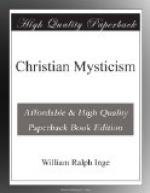MACARIUS.
“Thou comest not, thou goest
not;
Thou wert not,
wilt not be;
Eternity is but a thought
By which we think
of Thee.”
FABER.
“Werd als ein Kind, werd taub
und blind,
Dein eignes Icht muss werden
nicht:
All Icht, all
Nicht treib ferne nur;
Lass Statt, lass Zeit, auch
Bild lass weit,
Geh ohne Weg den schmalen
Steg,
So kommst du auf
der Wueste Spur.
O Seele mein, aus Gott geh
ein,
Sink als ein Icht in Gottes
Nicht,
Sink in die ungegruendte
Fluth.
Flich ich von Dir, du kommst
zu mir,
Verlass ich mich, so find
ich Dich,
O ueberwesentliches
Gut!”
Mediaeval German Hymn.
“Quid caelo dabimus? quantum est
quo veneat omne?
Impendendus homo est, Deus esse ut possit
in ipso.”
MANILIUS.
PRACTICAL AND DEVOTIONAL MYSTICISM
“We all, with unveiled face reflecting as a mirror the glory of the Lord, are transformed into the same image, from glory to glory.”—2 COR. iii. 18.
The school of Eckhart[257] in the fourteenth century produced the brightest cluster of names in the history of Mysticism. In Ruysbroek, Suso, Tauler, and the author of the Theologia Germanica we see introspective Mysticism at its best. This must not be understood to mean that they improved upon the philosophical system of Eckhart, or that they are entirely free from the dangerous tendencies which have been found in his works. On the speculative side they added nothing of value, and none of them rivals Eckhart in clearness of intellect. But we find in them an unfaltering conviction that our communion with God must be a fact of experience, and not only a philosophical theory. With the most intense earnestness they set themselves to live through the mysteries of the spiritual life, as the only way to understand and prove them. Suso and Tauler both passed through deep waters; the history of their inner lives is a record of heroic struggle and suffering. The personality of the men is part of their message, a statement which could hardly be made of Dionysius or Erigena, perhaps not of Eckhart himself.
John of Ruysbroek, “doctor ecstaticus,” as the Church allowed him to be called, was born in 1293, and died in 1381. He was prior of the convent of Gruenthal, in the forest of Soignies, where he wrote most of his mystical treatises, under the direct guidance, as he believed, of the Holy Spirit. He was the object of great veneration in the later part of his life. Ruysbroek was not a learned man, or a clear thinker.[258] He knew Dionysius, St. Augustine, and Eckhart, and was no doubt acquainted with some of the other mystical writers; but he does not write like a scholar or a man of letters. He resembles Suso in being more emotional and less speculative than most of the German school.




